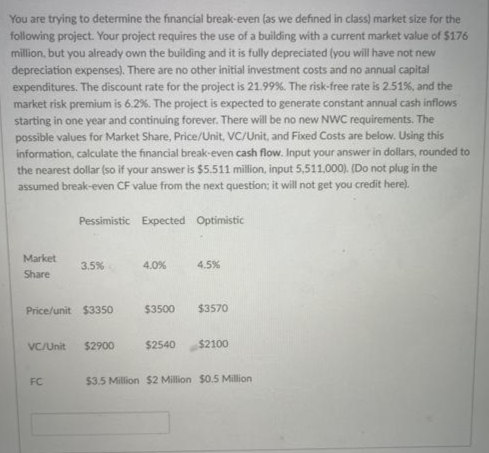You are trying to determine the financial break-even (as we defined in class) market size for the following project. Your project requires the use of a building with a current market value of $176 million, but you already own the building and it is fully depreciated (you will have not new depreciation expenses). There are no other initial investment costs and no annual capital expenditures. The discount rate for the project is 21.99 %. The risk-free rate is 2.51%, and the market risk premium is 6.2%. The project is expected to generate constant annual cash inflows starting in one year and continuing forever. There will be no new NWC requirements. The possible values for Market Share, Price/Unit, VC/Unit, and Fixed Costs are below. Using this information, calculate the financial break-even cash flow. Input your answer in dollars, rounded to the nearest dollar (so if your answer is $5.511 million, input 5,511,000). (Do not plug in the assumed break-even CF value from the next question; it will not get you credit here). Market Share Pessimistic Expected Optimistic 3.5% Price/unit $3350 FC 4.0% 4.5% $3500 $3570 VC/Unit $2900 $2540 $2100 $3.5 Million $2 Million $0.5 Million
You are trying to determine the financial break-even (as we defined in class) market size for the following project. Your project requires the use of a building with a current market value of $176 million, but you already own the building and it is fully depreciated (you will have not new depreciation expenses). There are no other initial investment costs and no annual capital expenditures. The discount rate for the project is 21.99 %. The risk-free rate is 2.51%, and the market risk premium is 6.2%. The project is expected to generate constant annual cash inflows starting in one year and continuing forever. There will be no new NWC requirements. The possible values for Market Share, Price/Unit, VC/Unit, and Fixed Costs are below. Using this information, calculate the financial break-even cash flow. Input your answer in dollars, rounded to the nearest dollar (so if your answer is $5.511 million, input 5,511,000). (Do not plug in the assumed break-even CF value from the next question; it will not get you credit here). Market Share Pessimistic Expected Optimistic 3.5% Price/unit $3350 FC 4.0% 4.5% $3500 $3570 VC/Unit $2900 $2540 $2100 $3.5 Million $2 Million $0.5 Million
Managerial Economics: A Problem Solving Approach
5th Edition
ISBN:9781337106665
Author:Luke M. Froeb, Brian T. McCann, Michael R. Ward, Mike Shor
Publisher:Luke M. Froeb, Brian T. McCann, Michael R. Ward, Mike Shor
Chapter5: Investment Decisions: Look Ahead And Reason Back
Section: Chapter Questions
Problem 5.4IP
Related questions
Question
Answer in typing other wise downvote you

Transcribed Image Text:You are trying to determine the financial break-even (as we defined in class) market size for the
following project. Your project requires the use of a building with a current market value of $176
million, but you already own the building and it is fully depreciated (you will have not new
depreciation expenses). There are no other initial investment costs and no annual capital
expenditures. The discount rate for the project is 21.99 %. The risk-free rate is 2.51%, and the
market risk premium is 6.2%. The project is expected to generate constant annual cash inflows
starting in one year and continuing forever. There will be no new NWC requirements. The
possible values for Market Share, Price/Unit, VC/Unit, and Fixed Costs are below. Using this
information, calculate the financial break-even cash flow. Input your answer in dollars, rounded to
the nearest dollar (so if your answer is $5.511 million, input 5,511,000). (Do not plug in the
assumed break-even CF value from the next question; it will not get you credit here).
Pessimistic Expected Optimistic
Market
Share
3.5%
Price/unit $3350
VC/Unit $2900
FC
4.0%
4.5%
$3500 $3570
$2540 $2100
$3.5 Million $2 Million $0.5 Million
Expert Solution
This question has been solved!
Explore an expertly crafted, step-by-step solution for a thorough understanding of key concepts.
Step by step
Solved in 3 steps

Knowledge Booster
Learn more about
Need a deep-dive on the concept behind this application? Look no further. Learn more about this topic, economics and related others by exploring similar questions and additional content below.Recommended textbooks for you

Managerial Economics: A Problem Solving Approach
Economics
ISBN:
9781337106665
Author:
Luke M. Froeb, Brian T. McCann, Michael R. Ward, Mike Shor
Publisher:
Cengage Learning

Managerial Economics: Applications, Strategies an…
Economics
ISBN:
9781305506381
Author:
James R. McGuigan, R. Charles Moyer, Frederick H.deB. Harris
Publisher:
Cengage Learning

Economics: Private and Public Choice (MindTap Cou…
Economics
ISBN:
9781305506725
Author:
James D. Gwartney, Richard L. Stroup, Russell S. Sobel, David A. Macpherson
Publisher:
Cengage Learning

Managerial Economics: A Problem Solving Approach
Economics
ISBN:
9781337106665
Author:
Luke M. Froeb, Brian T. McCann, Michael R. Ward, Mike Shor
Publisher:
Cengage Learning

Managerial Economics: Applications, Strategies an…
Economics
ISBN:
9781305506381
Author:
James R. McGuigan, R. Charles Moyer, Frederick H.deB. Harris
Publisher:
Cengage Learning

Economics: Private and Public Choice (MindTap Cou…
Economics
ISBN:
9781305506725
Author:
James D. Gwartney, Richard L. Stroup, Russell S. Sobel, David A. Macpherson
Publisher:
Cengage Learning

Microeconomics: Private and Public Choice (MindTa…
Economics
ISBN:
9781305506893
Author:
James D. Gwartney, Richard L. Stroup, Russell S. Sobel, David A. Macpherson
Publisher:
Cengage Learning